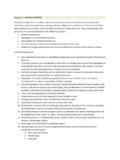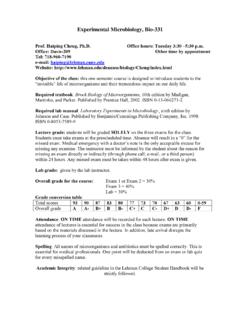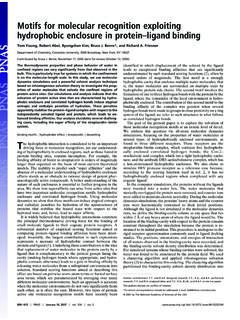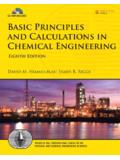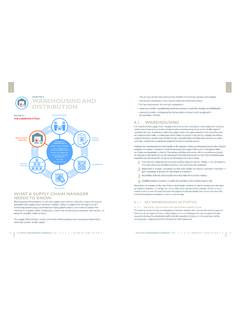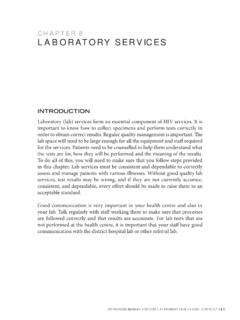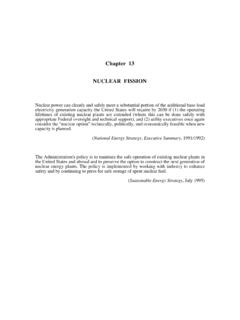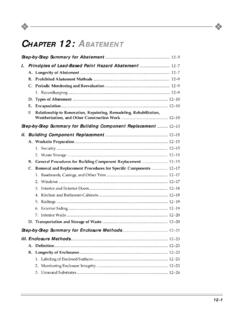Transcription of Chapter 5: CHEMICAL STORAGE - Lehman
1 Chapter 5: CHEMICAL STORAGE CHEMICAL STORAGE areas in academic laboratory settings include central departmental stockrooms, storerooms, laboratory work areas, STORAGE cabinets, refrigerators and freezers. There are established legal requirements as well as recommended practices for storing chemicals. These requirements and guidelines are summarized below in the following sections: General requirements Segregation of incompatible chemicals Specifications for CHEMICAL storerooms CHEMICAL STORAGE in laboratories (outside of CHEMICAL storerooms) Additional STORAGE requirements and recommendations for specific hazard CHEMICAL classes General Requirements 1.
2 Every CHEMICAL should have an identifiable STORAGE place and should be returned to that location after use. 2. A STORAGE scheme must be developed in each CHEMICAL STORAGE area to ensure the segregation of incompatibles and efforts must be made to isolate particularly flammable, reactive, and toxic materials. An exclusively alphabetical STORAGE scheme is prohibited. 3. CHEMICAL STORAGE on benchtops will be minimized in order to reduce the amounts of chemicals unprotected from a potential fire or easily knocked over. 4. Compatible chemicals should be grouped by container size to make it easier to retrieve chemicals and to reduce the possibility of bottle breakage.
3 5. CHEMICAL STORAGE in hoods will be minimized. Storing containers inside the hood interferes with airflow, reduces and clutters up the work space, and provides fuel in a fire or explosion. Where possible, chemicals will be stored in separate cabinets which vent directly into the fume hood. 6. Labels must be maintained on all stored materials. 7. Stored chemicals must not be exposed to direct sunlight or heat. 8. STORAGE trays should be used to minimize the spread of a spill. 9. Laboratory refrigerators must never be used to store food. 10. All chemicals containers left out of STORAGE areas must be checked at the end of each workday.
4 Unneeded items must be returned to CHEMICAL storerooms or stockrooms. 11. Store acids (inorganic and some organic acids) in a dedicated acid cabinet. Oxidizing acids must be isolated from other acids ( , each in its own separate secondary containment). 12. Store flammables in a dedicated flammables cabinet. Acetic acid and acetic anhydride must be stored in a flammable cabinet. 13. Store highly toxic chemicals in a dedicated cabinet. 14. Opening/expiration dates must be assigned to chemicals with the following functional groups/ CHEMICAL properties: a. Picric acid and Picrates b. Perchlorates c. Peroxides d. Peroxidizable materials (aldehydes, ethers, compounds containing benzylic hydrogen atoms).
5 Peroxidizable materials must be tested routinely for peroxides e. Monomers that polymerize violently or become hazardous after polymerization f. Other materials known to deteriorate or become unstable or reactive over time 15. All laboratory personnel, on termination, transfer, or graduation must (in conjunction with the laboratory supervisor and CHO) arrange for the redistribution, removal or safe STORAGE of all hazardous materials remaining in their laboratory. 16. Appropriate spill control, clean-up and emergency equipment must be available wherever chemicals are stored. See Chapter 8 for guidance in choosing these materials. Segregation of Incompatible Chemicals Chemicals must not be arranged alphabetically or haphazardly in stockrooms or in laboratory work areas.
6 Alphabetical arrangement of chemicals can inadvertently place two incompatible chemicals next to each other, which in the event that the containers break or leak could react violently. Some examples: Acetic acid + Acetaldehyde = explosive reaction Aluminum metal + Ammonium nitrate = potential explosive Cupric sulfide + Cadmium chlorate = explode on contact Mercury II oxide + Magnesium metal = potential explosive Sodium nitrite + Sodium hypophosphite = explosive Numerous approaches can be taken to segregate chemicals in STORAGE . Different approaches may be required depending upon the type and amount of space available for STORAGE and the environmental conditions of the spaces.
7 Major considerations for segregation criteria should include water reactivity and flammability. Special attention must be paid to the following chemicals due to their potential reactivity: INORGANIC Nitrates Nitrites ORGANIC Metal azides Perchlorates Perchloric acid Ethers Peroxides White phosphorus Phosphorus pentoxide Organic azides Particular attention must be paid to isolating flammable, pyrophoric, peroxidizable, and toxic chemicals. STORAGE of specific hazard classes of chemicals is discussed in greater detail below. CHEMICAL STORAGE Area Specifications Stockrooms are facilities used for storing relatively large quantities of chemicals for laboratory use.
8 General specifications for all CHEMICAL stockrooms: Stockroom access must be strictly limited to specified personnel. All laboratories, preparation rooms, and storeroom/stockrooms must be locked and secured when designated laboratory employees are not present. A mechanical exhaust ventilation system must be present and should provide at least 6 air changes per hour (FDNY). Additional local exhaust may be required if activities such as dispensing take place in the STORAGE area. Each STORAGE area should have at least 1 large sink, safety shower, eyewash station, and must have an appropriate fire extinguisher with adequate extinguishing capacity.
9 Each CHEMICAL STORAGE area should have a master control shut-off valve for water, electricity, and utility gas. Shelf assemblies must be firmly secured to walls. Weight limits provided by the manufacturer must not be exceeded. Avoid island shelf assemblies. Large containers should be stored on lower shelves. No chemicals should be stored above eye level and avoid top shelf CHEMICAL STORAGE . Chemicals must not be stored on the floor. Metal shelving assemblies should be of heavy gauge construction with a durable baked-on chemically resistant or epoxy finish. Wooden shelves should have chemically resistant coverings. Although wood may be more absorbent to liquids than steel, it is less reactive and more resistant to a wide range of chemicals.
10 Wood shelves should not be used to store nitric acid, perchloric acid or other chemicals that react vigorously with organic materials. Shelves should have anti-roll edges to prevent containers from falling off shelves. Avoid adjustable metal shelf supports or clips and ensure that aisles between shelves are at least 3 feet wide. All CHEMICAL storerooms and stockrooms must have clearly-marked, unobstructed exits. Each area should have two exits. CHEMICAL stockrooms must be well-illuminated so that labels can be easily read. No aisle should dead end. Aisles must be kept clear of clutter. The environment in stockrooms must be controlled to avoid extremes of temperature and high humidity.
